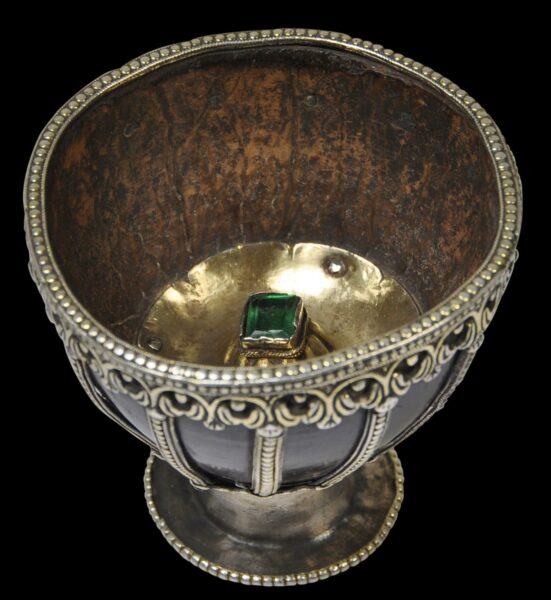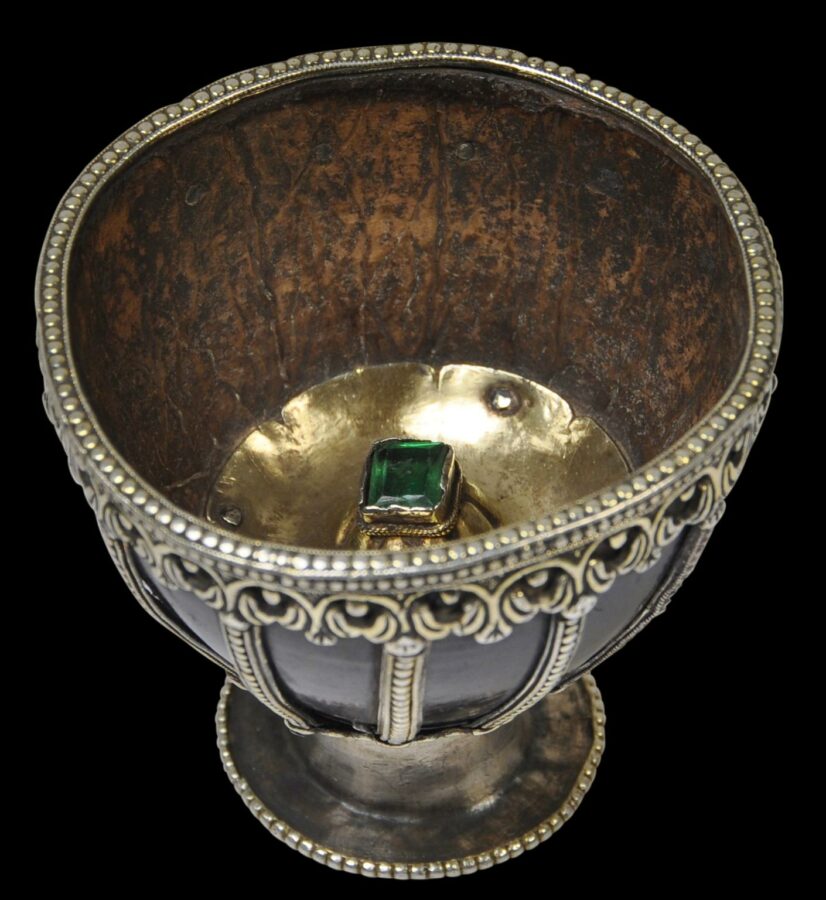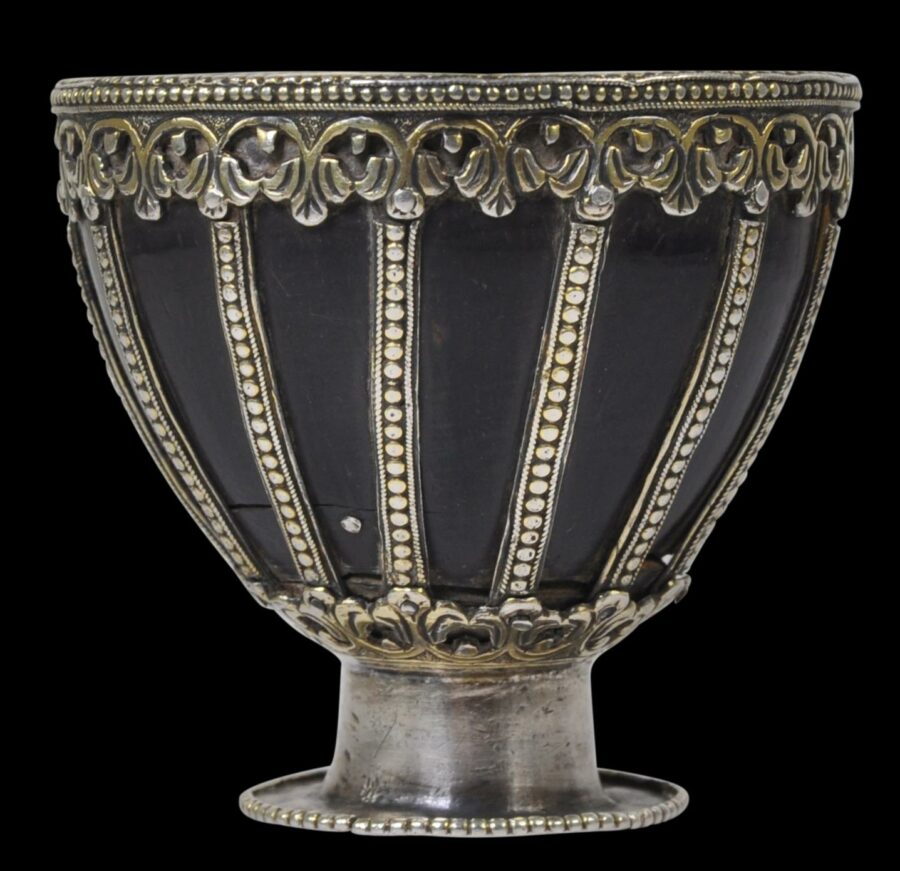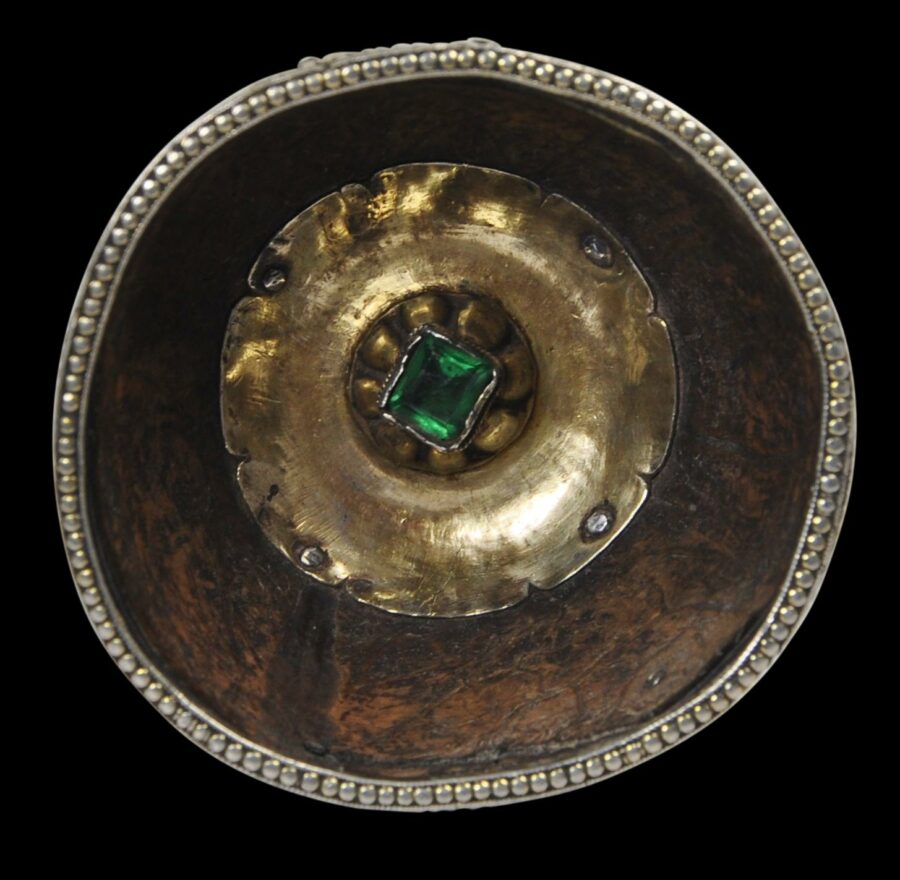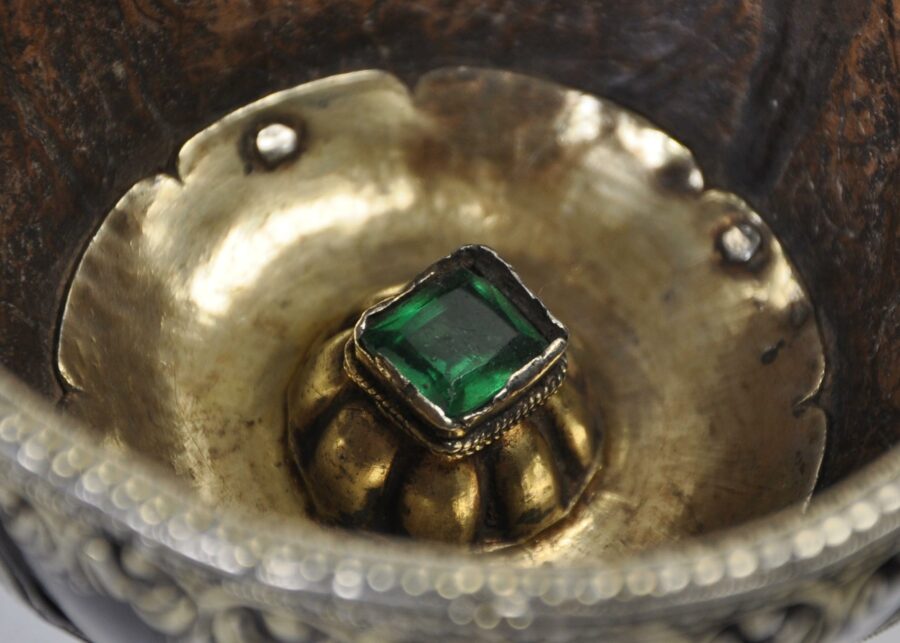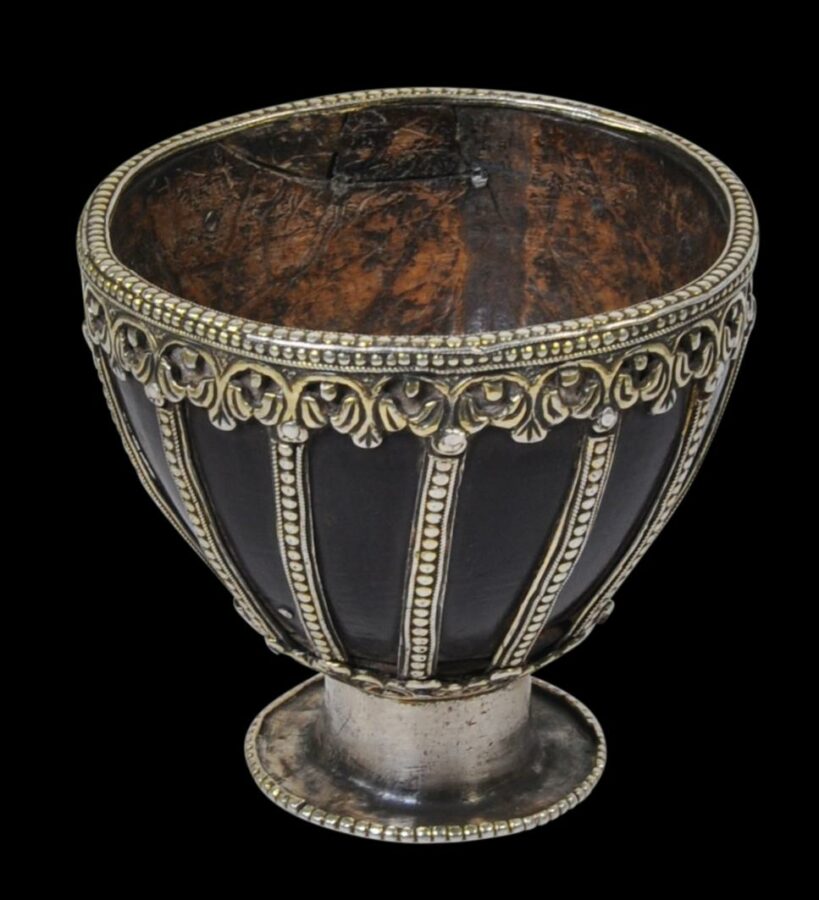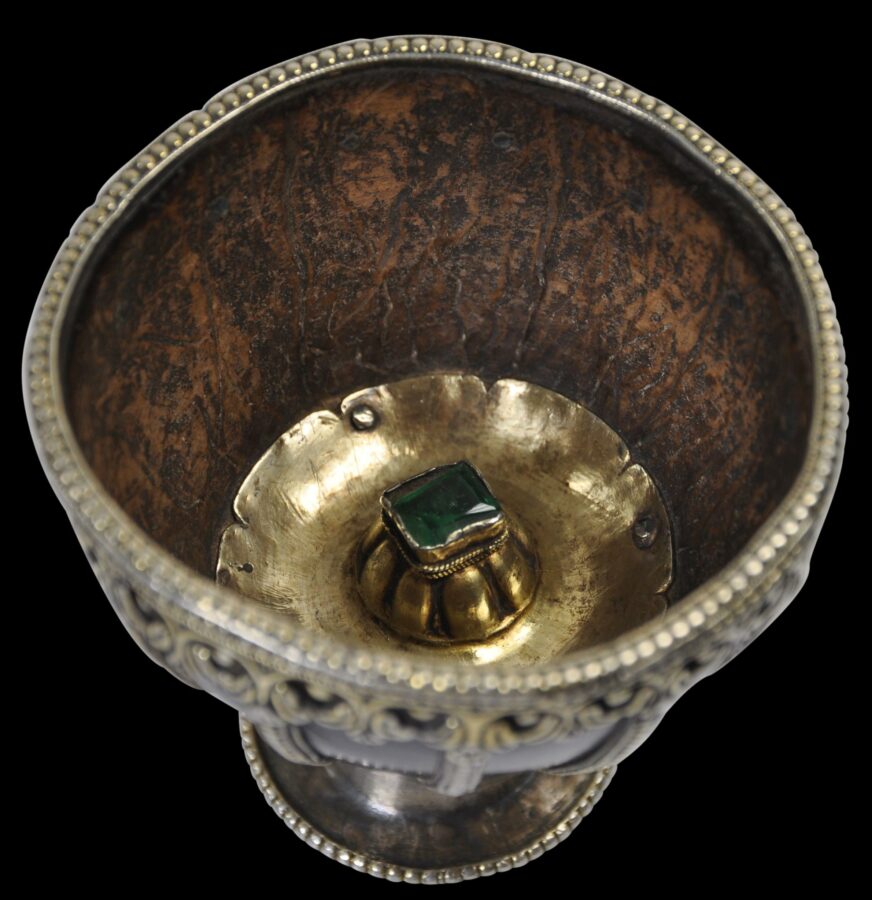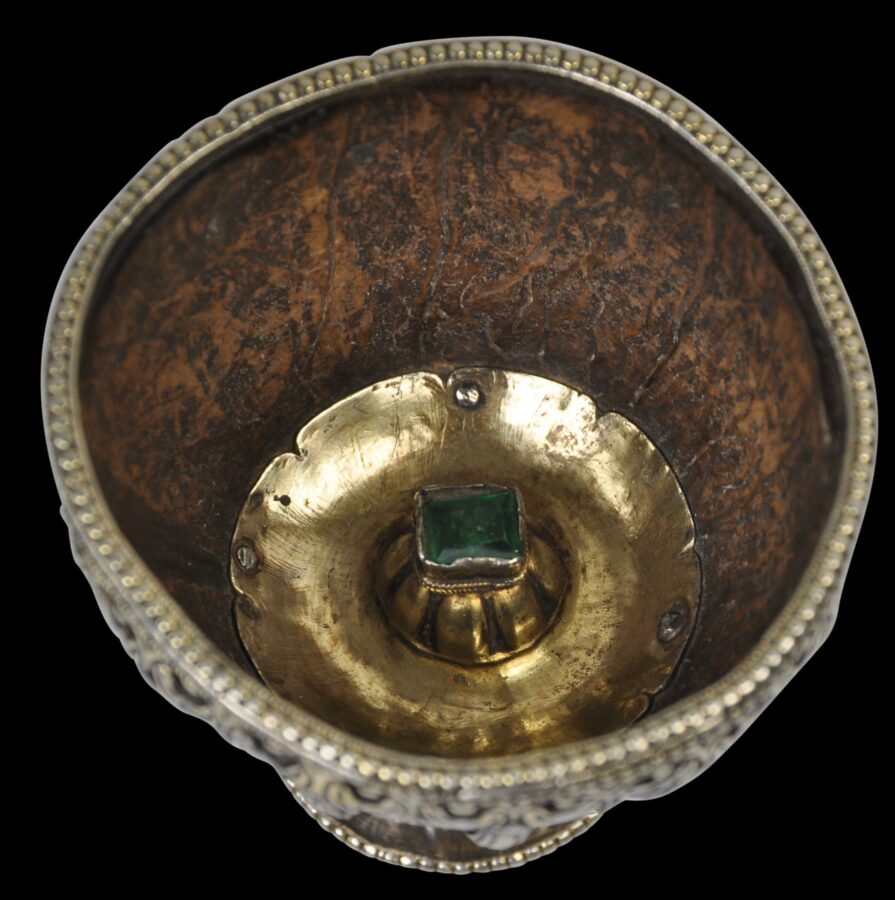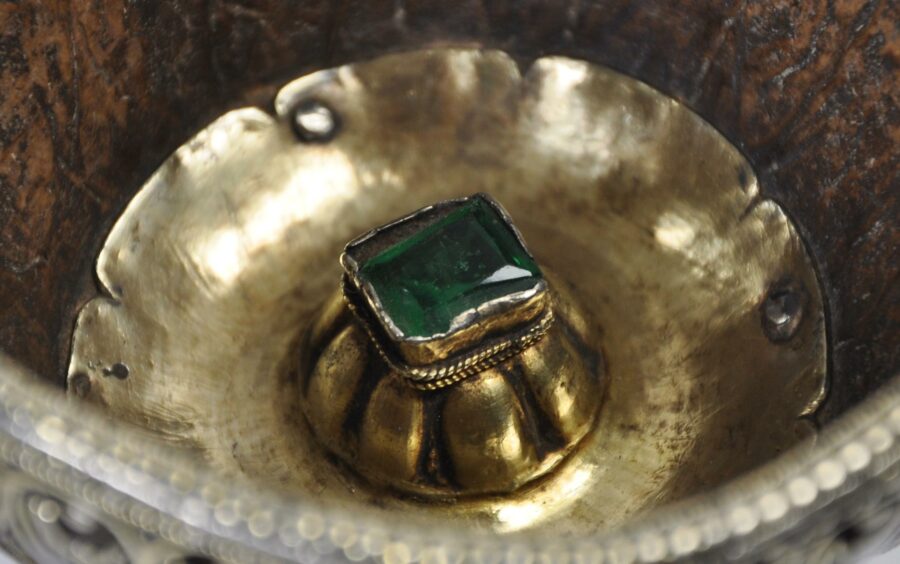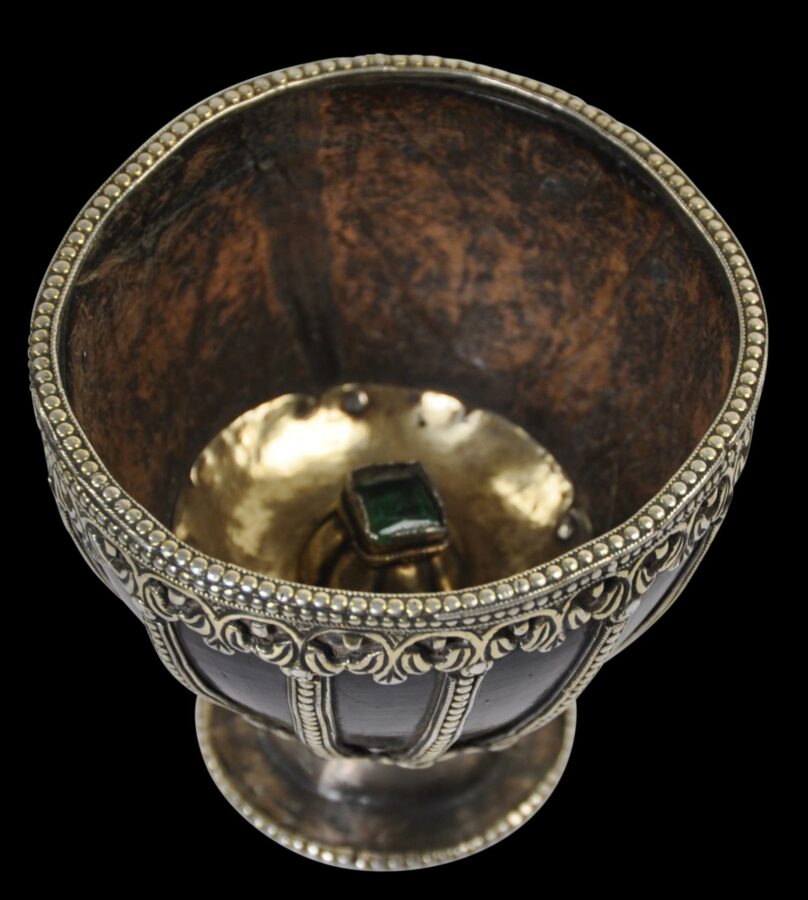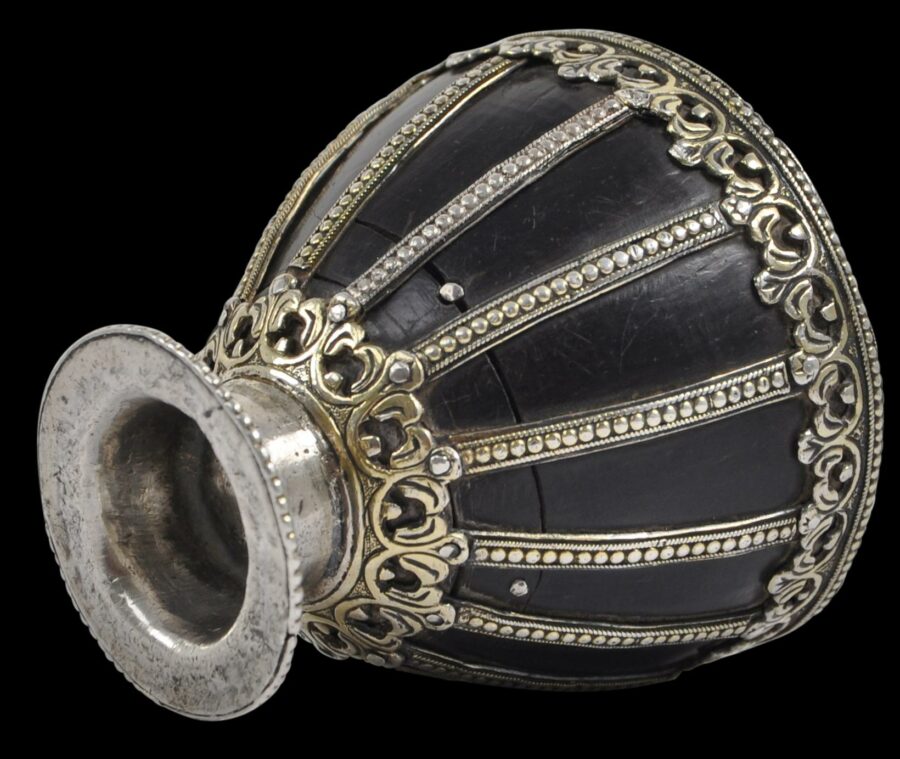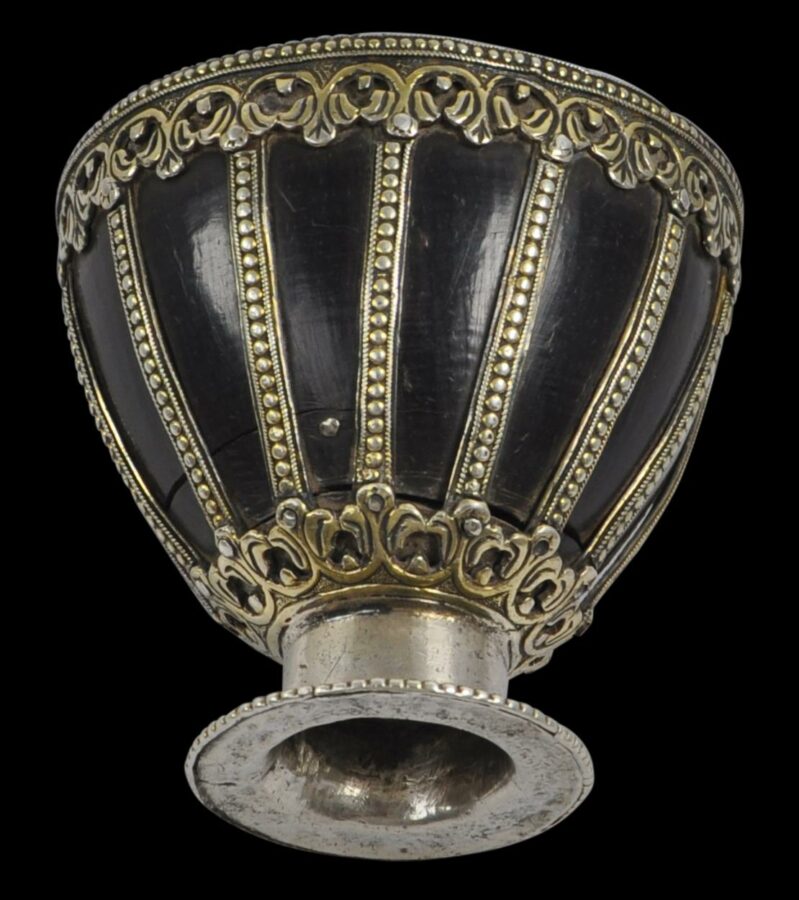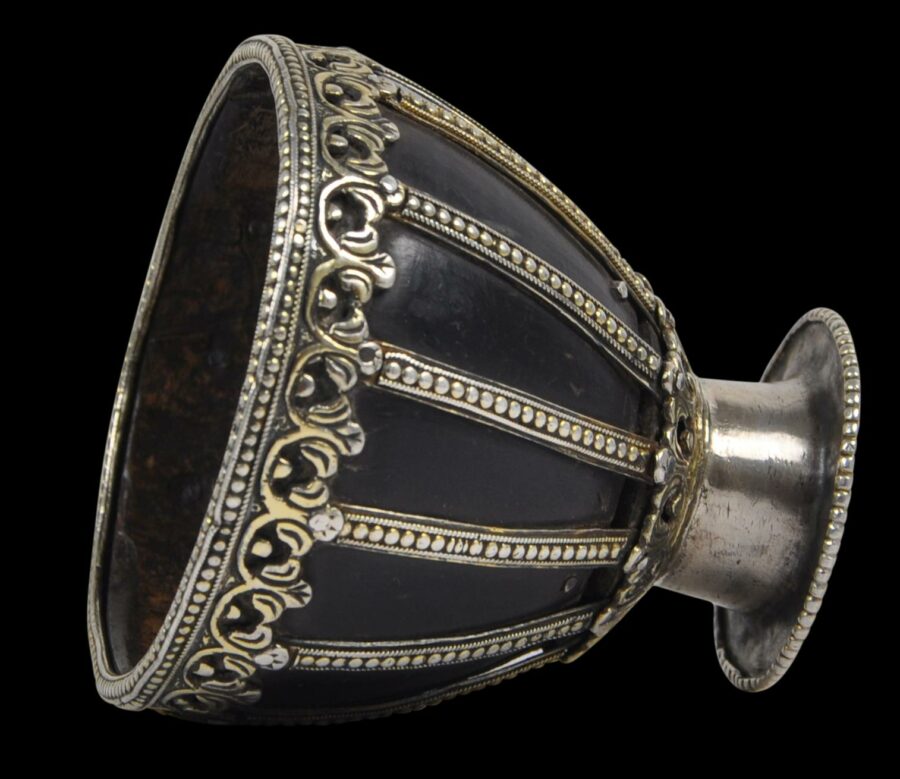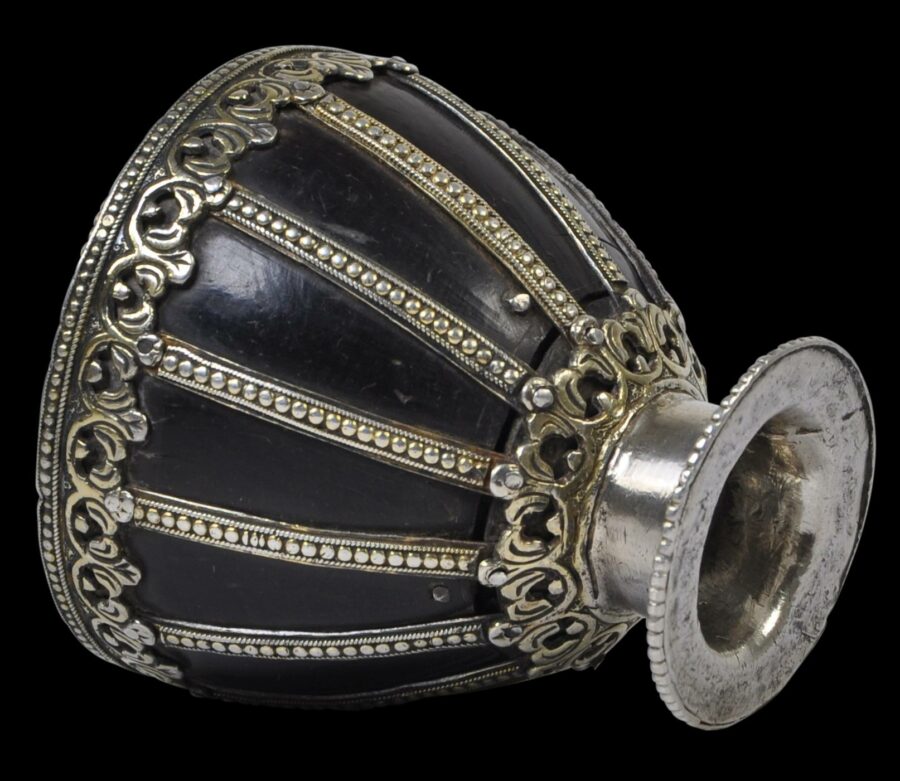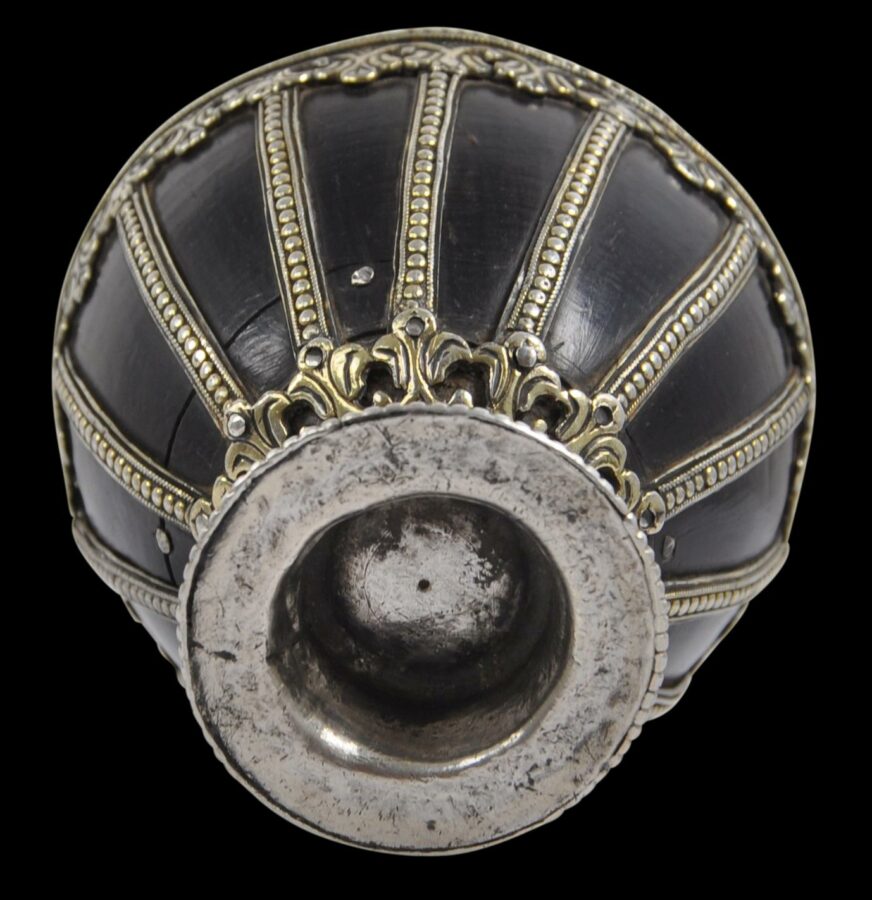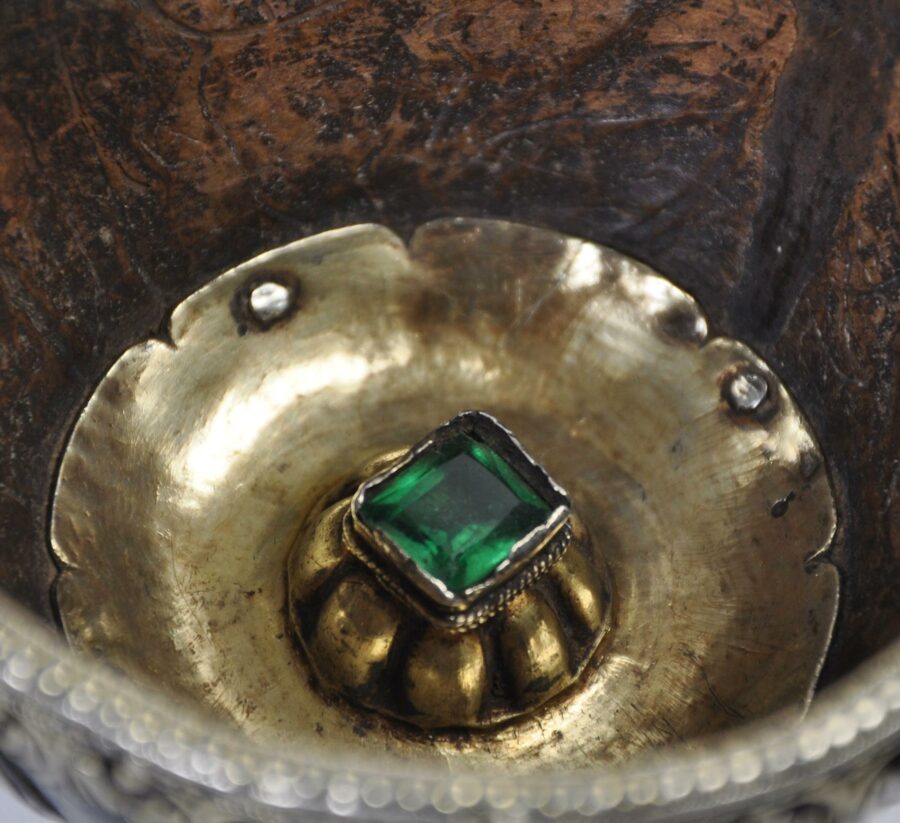Enquiry about object: 9399
Exceptionally Rare Indian ‘Medicine’ Coconut Goblet with Silver-Gilt Mounts
Western India, perhaps Goa, or Mughal India 16th century
height: approximately 7.2cm, diameter: approximately 7.9cm, weight: 143g
Provenance
private collection, London,. UK; by repute, a Russian collection
This goblet is of the utmost rarity – we are not aware of another like it. Made of coconut shell with fine, gold-plated silver mounts, the interior is fitted with a green stone or perhaps green glass to impart medicinal qualities to the liquid it holds, or perhaps to neutralise poison.
Importantly, all components of the goblet have incontrovertible patina. The gilding on the mounts has worn over the centuries to develop a softened, delicate hue, enhancing the beauty of the goblet.
The goblet comprises a small coconut shell cut to make the body of a cup or goblet. It has been mounted with beautifully chased silver mounts that have been plated with gold. It sits on a splayed foot, the edge of which has silver beading. The body of the goblet is held in place with thirteen beaded silver struts, held in place between pierced and engraved acanthus leaf borders at the top and the bottom of the coconut body of the goblet. The rim of the coconut is encased in beaded silver. The silver mounts have been riveted to the coconut shell with gilded silver rivets.
The interior of the base of the goblet has a gilded silver plate held in place with four rivets, and from the centre of this rises a bevelled green stone in a high box setting that has been additionally decorated with petals and with gilded braided silver wire. The early cutting of the stone is consistent with the age of the piece.
The silver mounts are those of Western India – perhaps Goa – and are consistent with a 16th or early 17th century dating.
The goblet might have been made for the European market, but equally might have been intended for a member of the Mughal court or similar.
The goblet can be seen to be in the tradition of bezoar stones which were immersed in water to impart to the water curative properties, or were seen as able to detect or neutralise poison, and Islamic brass ‘medicine’ bowls which have interiors engraved with talismanic Koranic script and when filled with water were believed to impart some of their magical properties to the water which was then drunk.
It is possible that the goblet has its origins in the Indo-Portuguese settlement Goa on India’s west coast, which was an international source of ‘exotica’ and other luxury goods. By the late 16th century, Goa was one of the world’s most important clearing houses for ‘exotic’ stones too. Goa origins conferred such a degree of exotica, and thus a premium, that Portuguese merchants would purchase emeralds and other stones in Seville, ship them to Goa so that other Europeans would buy them there, but now with the cache of their being ‘from’ Goa. But such stones were highly valued in India itself.
The green stone at the base of goblet here is not an emerald but certainly presents as one. As stated by Lowe (2024, p. 13), ‘…authenticity was an issue in the sixteenth century, and the copying of desirable and popular objects, such as bezoar stones, was rampant.’
The concept of using emeralds and emerald-like stones for medicinal purposes has precedence in India.
A pair of glasses with flat-cleaved emeralds as lenses and with frames set with diamonds purportedly from Mughal India came onto the London art market several years ago. It was suggested that the emerald lenses had healing or restorative properties and were an aid for eye ailments.
Keene (2001, p. 133) illustrates a miniature cup carved entirely from a single green emerald which is carved on all sides with verses in Persian, and which is attributed to 16th-17th century Deccan or Mughal India. It seems likely that apart from the sheer opulence of this piece, its other intended purpose was to impart curative powers to the liquids sipped from it.
The use of green stones – not necessarily emeralds – was practiced widely in gold jewellery made in Indo-Portuguese Goa where such items that date even to the 17th century were made of gold and set not with emeralds but with green glass. See for example Penalva (2014, p. 110).
Green is also the colour of the popular Islamic Indian saint Khwajar Khizr (also known as Zinda Pir) who was believed to have found the fountain or water of eternal life. Typically the saint is shown turbaned, clad in a green robe, and riding a fish. Sometimes he is known as ‘the Green One’. Another legend holds that Khawaja Khizr is the saint who guided Prophet Moses. Khawaja Khizr’s tomb is believed to be on an island near Sukkur in the Indus River in what is now Pakistan. The saint is popular among India’s sufis and most legends associated with the saint have some connection with water, or rituals related to water. Interestingly, the saint is not only revered by Muslims In India but also by Hindus.
The green stone used in the goblet here can also viewed in this context.
The goblet is heavy in the hand. The silver used is thick and quite pure The coconut has the expected age-related shrinkage cracks, but these are stable given the pinning of the silver mounts. As mentioned, the gilding has much age-related wear and so has softened to a beautiful colour.
Overall, this is a very important, museum-quality item.
References
Penalva, L. et al, Espendores do Oriente: Joias de Ouro da Antia Goa/Splendours of the Orient: Gold Jewels from Old Goa, Museu Nacional de Atre Antiga, 2014.
Keene, M., Treasury of the World: Jewelled Arts of India in the Age of the Mughals – The Al-Sabah Collection, Kuwait National Museum, Thames & Hudson, 2001.
Lowe, K.J.P., Provenance and Possession: Acquisition from the Portuguese Empire in Renaissance Italy, Princeton University Press, 2024.
Vassallo e Silva, N., ‘Jewels for the Great Mughal: Goa a centre of the gem trade in the Orient’, in Jewellery Studies, Volume 10, 2004.
Vassallo e Silva, N., & J. Flores, Goa and the Great Mughal, Calouste Gulbenkian Foundation, 2004.


